Tokugawa Ieyasu: Hostage, Shogun, God (1 part)
Hijoshi Toyotomi: "We must make him sing!"
Izyasu Tokugawa: "I will wait until I start singing ..."
Here we come, finally, to the story of a man unique, even by Japanese standards, of fate. A person of a not too significant kind, who was held hostage since childhood, but by the will of fate and his talents, he became the ruler of Japan and declared a deity after death. Moreover, he not only achieved the highest, after the emperor, power in the country, and the power is quite real, not nominal, but also transferred it to his children, establishing the rule of the Tokugawa clan in Japan for ... 265 years! So much, from 1603 to 1868 a year, ruled the shoguns of his family in the country, ensuring her peace, preservation of culture, traditions and complete economic stagnation, which almost turned into a national catastrophe and complete loss of independence for her!
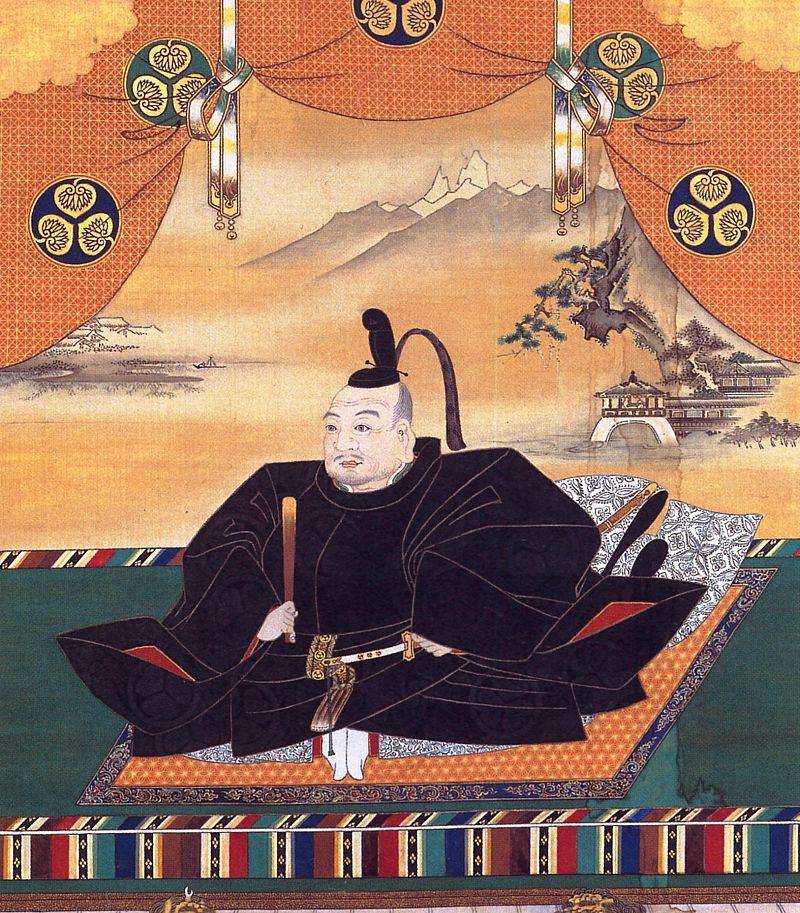
This is how Ieyasu Tokugawa looks like in the Japanese pictorial tradition.
But, of course, he could not know what his descendants would lead him now. He just wanted the best for them and for the country. Note that in stories There were quite a few rulers all over the world, to whose name the word “Great” was added. But what does it mean for a ruler to be great? Well, first of all, probably, the ruler should unite the country or territories under his control into one economic and cultural whole and, we note, many have managed to do this. This is both Cyrus the Great, and Alexander the Great, and Peter the Great, and Catherine the Second, and Joseph Stalin - why not? We are hardly mistaken if we add that such a ruler was to happily fight and either push the limits of his own power, or defend its territorial integrity in the fight against the enemy. And here we meet all the same names. But such an important condition of "greatness" as the continuity of its course for most of the above historical characters is an unattainable dream. Well, they did not give this most important circumstance the necessary attention. Alexander died, and immediately his closest associates tore the empire apart, and his mother, wife and son were killed. Peter the Great died by tracing: “Give it all away ...” and nothing more. Catherine was succeeded by Paul, who began to do everything in his own way and eventually received an ashtray in his temple. Well, and no less great Stalin ended his life alone, surrounded by half-friends, half-enemies, and left not only an heir (son Vasily does not count, of course, this is a son, not an heir!), But also a successor of his cause. Why it happened - the topic of a separate article. The main thing is that it happened. Well, the empire created by him also proved to be short-lived, although it survived in the greatest of wars.
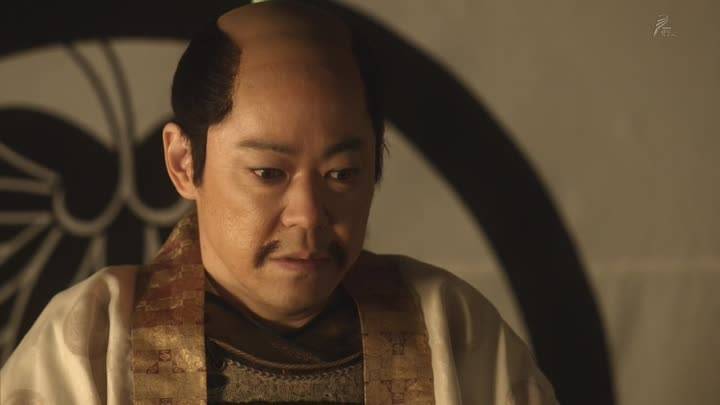
And so in the series "Nayotor, the mistress of the castle."
But Tokugawa Ieyasu didn’t receive the nickname “Great” in his lifetime. But on the other hand, he was honored after the death of the name of Tosho-Digongan (“The Great Savior God, that illuminated the East”), under which he was put on the list of Kami deities. Of course, the characters we named here, so directly, are not quite correct to compare. Many had different tasks, they lived in different eras with different levels of technology, but ... nevertheless, the stability of the Tokugawa shogunate is still revealing: 265 years of the same family! Moreover, he did not have a theory that would unite the masses, was not faithful to her ideas and to himself, the parties, but there were only adherents bought for rice rations and an oath of loyalty, there were no trusted and controlled media, there wasn’t much . And nevertheless, he succeeded in something that nobody in Japan had succeeded in before! Yes, the shoguns were before Ieyasu Tokugawa, but their clans still did not rule for so long! So, the first shooter Minamoto in Japan existed 141 year. The same term is considerable, but still less than the second Ashgaga shogunate, whose reign lasted 235 years, but again it was shorter than the last, third, with Edo’s capital. And despite the fact that Ieyasu himself was a shogun for only two years! In 1603, he received this title, and in 1605 he passed it on to his son Hidetad. Having bestowed peace and stability on the Japanese people, Tokugawa died in 1616.
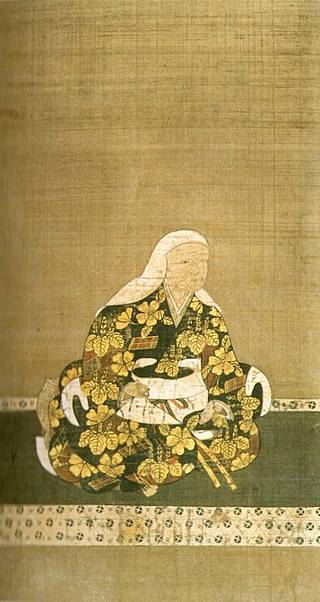
Mother Ieyasu Tokugawa.
Naturally, the life of such a person is of great interest and that is why we will tell you about him ...
Born Tokugawa Ieyasu in the 1543 year, he belonged to the samurai family of Matsudaira, an ancient but seedy one. His father was Matsudaira Hirotada, the eighth head of the Matsudaira clan and the daimyo of Mikawa province. As a child, Ieyasu bore the name Taketiyo and very early on experienced what it means to be a representative of a weak race. The fact is that the lands belonging to the Matsudaira clan were so unsuccessfully located that from the east and west of them were much more powerful neighbors who constantly fought with each other. That is why almost the main occupation of the clan members was the debate about whose ally it is best to become, that is - simply speaking, to whom and for what, with the greatest profit to sell! Part of the vassals of the clan "kept the side" of their western neighbor Oda Nobuhide, but others called for the obedience of a daimyo who was in the east - Imagawa Yoshimoto. Grandfather Ieyasu Matsudaira Kiyoyasu (1511 — 1536) in one of the quarrels over the choice of the overlord was even stabbed to death by his own vassals, because he wanted to contact the Oda family and wanted to see the overlord Imagawa family. Therefore, the father of the future unifier of Japan had to be very careful not to repeat his fate! By the way, Ieyasu's mother was from a family that usually adhered to western neighbors, so when in 1545, most of the vassals of the Matsudaira clan began to insist on the support of Imagawa Yoshimoto, he had to expel her from her residence. The opinion of relatives and vassals turned out to be stronger than his power of the head of the clan!
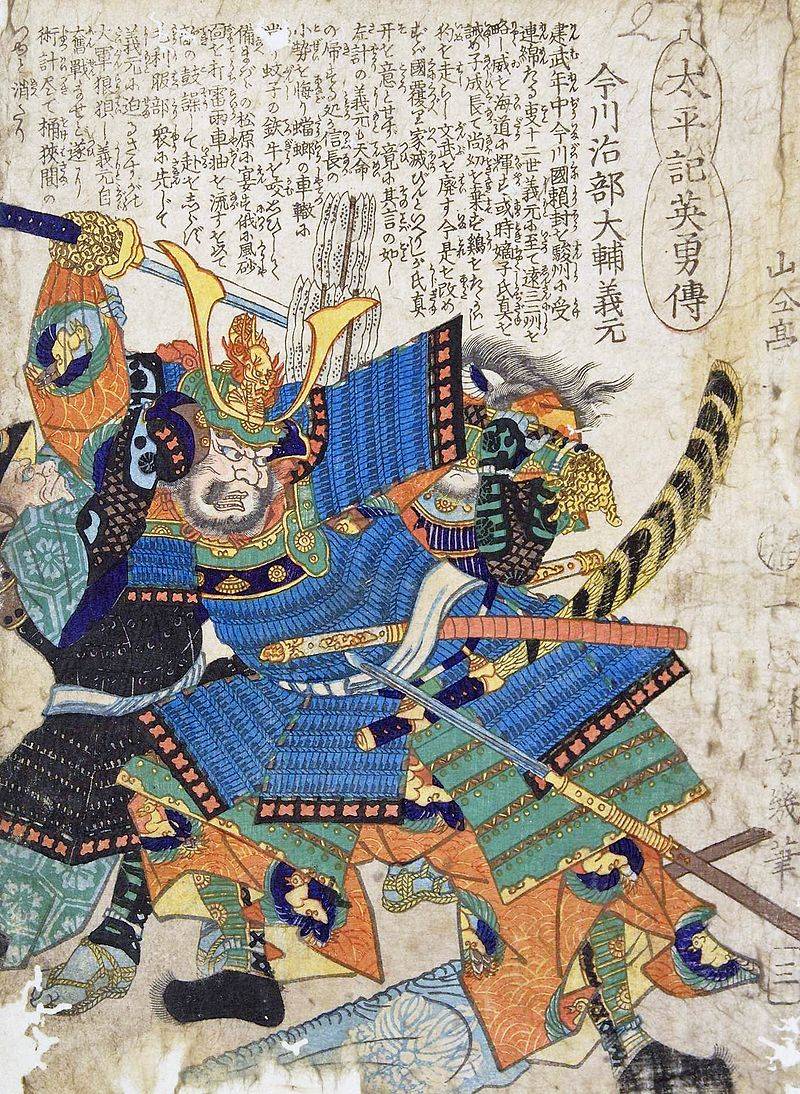
Imagawa Yoshimoto. U-kiyo Utagawa Yoshiyku.
When in 1548, Oda's army attacked the lands of the Matsudaira family, he asked for help from the powerful daimyo Imagawa Yoshimoto. And he, of course, agreed to help his vassal on the condition that the minor Ieyasu was given to him as a hostage. This automatically put the Matsudaira family in a subordinate position. But Father Ieyasu had no way out, and he agreed. But then the story began, worthy of Golluvid's militants, but nevertheless quite reliable. Oda Nobukhide learned about Hirotad's intention to give away his son Imagawa and thus buy his military support for himself and ... organized the kidnapping of six-year-old Ieyasu using secret agents. He reasoned quite logically - there is no son, no hostage, but no hostage, then there is no alliance, because Imagawa will simply decide that Ieyasu is being hidden from him!
But it turned out that the duty of the head of the clan for Hirotad turned out to be higher than his father's love, and he decided that he could sacrifice his son, but a military alliance was impossible. And Nobuhide’s plan failed in this way. In theory, he should have killed Ieyasu right away, however, he decided that it was never too late and sent the boy to Mensyoji Monastery in the city of Nagoya, where he held him for three years. And it turned out that during this time the future shogun made friends with Oda Nobunaga, the son of his captor!
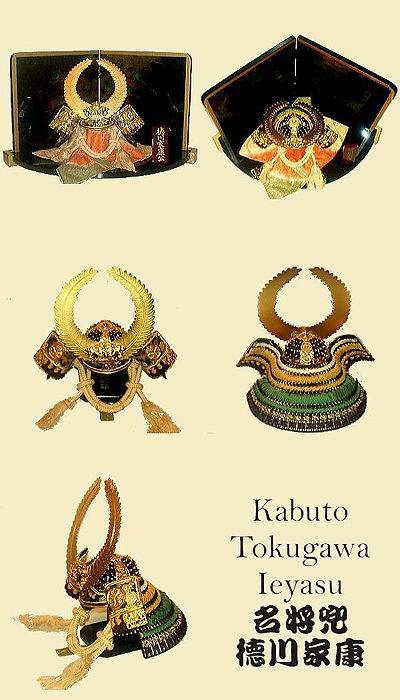
Image of the helmet Ieyasu Tokugawa.
And in 1549, Matsudaira Hirotada, Ieyasu’s father, was slaughtered by his own guard, and so the Matsudaira clan were left without a leader - the situation, again, very realistically shown in the TV series “Niotor, Mistress of the Castle”. According to the notions of that time, Imagawa Yoshimoto sent his man to their castle, which he was supposed to lead the clan on his behalf. But the duty of the samurai ordered to pull Ieyasu from the hands of Oda and make him the new head of the family. And this opportunity Imagava presented itself three years later, when Oda Nobuhide died from an ulcer, and now in his clan began internal strife and the struggle for leadership. Taking advantage of this, Imagawa's troops seized the castle, and in it the son of the late Nobuhide, Odu Nobuhiro, who was decided to exchange for nine-year-old Ieyasu. The vassals of the Matsudaira family, the return of a new gentleman, even a young one, made him very happy, but only Imagawa Yoshimoto insidiously deceived their expectations, and took Ieyasu to his capital, the city of Sunpu. That is, he again became a political hostage, but now with another person. And what to do if in Japan the nobility usually didn’t stand on ceremony with the local nobility (and, by the way, where did it know at least someone to stand on ceremony ?!) and in order for his samurai to remain faithful to their daimyo, take hostages from their families. Usually the eldest sons - the heirs who lived after that at the court of the "senior gentleman". So young Ieyasu thus became a hostage in the Imagava clan. But he lived there well: food, training from one of the best strategists at that time, Okhara Yusai, clothes and a room befitting his position — all that he had. In 1556, Imagawa Yoshimoto became his adoptive father and even personally held a legal age ceremony for the young hostage. Ieyasu got the name Matsudaira Jiro Motonobu. The following year, he actually forced him to marry his niece named Sen, that is, he made the hostage his relative, and gave him a new name, Motoyasu. Then a year later, Imagawa ordered Ieyasu command of the troops, which he successfully commanded in his first battle, seizing the castle of Teraba on the western border for Imagawa. All this time, Ieyasu had the sense to pretend to be such a simpleton (by the way, in the series “Nayotor, the mistress of the castle” this is also shown very well!), Constantly playing go (a popular game in Japan, like chess) with himself. That is, his personality did not arouse any particular envy of anyone in the genus Imagawa.
A table for the game of go that Ieyasu used.
But he pretended to be silly only before the Battle of Okhajazam (1560), in which the head of the clan Imagawa Yoshimoto was killed. Well knowing that Yoshimoto Ujizane’s son is very far from his father in all respects, and his own troops are under his arms, Ieyasu decided to rebel against his overlord as soon as he learned about Yoshimoto’s death in the Battle of Okehadzama, and make an alliance with his worst the enemy (and your friend!) - Oda Nobunaga!
In order to be free in all respects, he managed to bring his wife and son out of Sunpu, and then seize his ancestral castle Okazaki. Only after that, in 1561, Ieyasu decided to openly oppose the Imagawa clan, after which he took one of the forts that he had taken by storm. The next year, 1562, he finally made an alliance with Oda Nobunaga, in which he promised to fight with his enemies in the east. A year later, as a sign of the already complete break with the Imagava clan, he again changed his name and became known as Matsudaira Ieyasu.
After that, Ieyasu took up the affairs of administration in his lands, but in this he was disturbed by the Buddhist communities of fanatical monks of the Ikko-Iqq sect, who did not recognize his authority. They had to fight 1564 to 1566 of the year, but fortunately, for Ieyasu, this war ended with his complete victory to Ieyasu. He united all the lands of the province of Mikawa under his administration, for which the imperial court awarded him the honorary title "Mikawa no Kami" (Defender of Mikawa). Only now he felt really strong and once again changed his surname to Tokugawa - the surname of the descendants of the ancient samurai clan Minamoto.
In 1568, Ieyasu decided to form an alliance with another neighbor, already in the north - from Takeda, but again against the Imagawa family. In addition, he also participated in Oda Nobunaga's campaign on Kyoto, and assisted Ashikaga Yoshiaki, who was given the post of shogun.
Takeda Shingen at that time was a powerful ally who had a strong army. Therefore, it is not surprising that the Imagawa clan ceased to exist under the general attacks of Shingen and Tokugawa. Totomi province (the western part of the modern Shizuoka prefecture) now became owned by Ieyasu, and Shingen received the Suruga province (the eastern part of the modern Shizuoka prefecture). However, further their interests diverged. Takeda wanted to capture Kyoto, and the Tokugawa clan prevented him from doing so. Therefore, Shingen decided to destroy him and in 1570, he invaded Ieyasu, who at that time helped Ode Nabunage to fight the Sakura and Adzai clans.
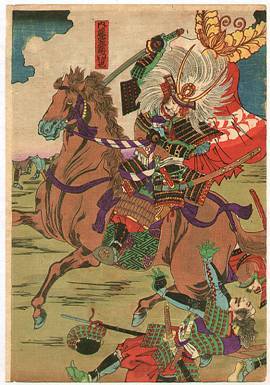
Battle of Mikatagahara. Triptych Tikanobu Toohara, 1885
The first strikes Teked Ieyasu repelled successfully. But in October, 1572, Takeda Shingen, personally led his troops into battle. Tokugawa had to ask for help from Oda Nobunaga, but he was completely absorbed in the war with the Azai, Asakura, and Buddhist rebels, and he could not render help to Ieyasu, and he had to act independently. He lost the battle of Itigendzak, which became a signal for his vassals to go over to the side of Takeda Shingen. The situation was particularly aggravated when the fortress of Futamat and the allies of Ieyasu fell, began to leave him one by one. Seeing the plight of an ally, Oda Nobunaga sent him three thousand soldiers. But still, having 11 of thousands of soldiers, Ieyasu simply could not win another battle with Takeda Shingen's 25-thousand army. Nevertheless, Ieyasu Tokugawa nevertheless decided to give the aggressor a “last fight” and on January 25 of the year 1573 attacked him from the rear. But even this cunning maneuver did not bring him success. As a result, the battle of Mikatagahara ended in a crushing defeat of the Ieyasu army. He barely managed to escape from the environment and return to his castle. In the film “Najotor, the mistress of the castle” showed that while he also did in his pants and, in principle, after the horror experienced by him after this battle it was quite possible!
The famous screen from the Ieyasu Tokugawa Museum, which depicts the Battle of Nagashino.
A fragment of a screen, which in the lower left corner shows a faithful associate of Ieyasu Honda Tadakatsu, which can be recognized by a helmet with reindeer horns.
But as it is written in the chronicles of that era (and this was indeed so, who would doubt!) "Kami would not leave Tokugawa", because when everything seemed to be lost for him, Takeda Shingen in February 1573 of the year suddenly fell ill and died. Tokuga initially so confused that he did not believe this news and in May of the same year he tried to bring back a number of fortresses and castles seized by Shingen in his lands. In response, complete silence, since Singen's son Katsuri was very far from his father, which he subsequently demonstrated in the Battle of Nagashino. And, of course, many of those local rulers, who yesterday sided with Takeda, immediately ran to express their submission to Ieyasu. So there could be no doubt - the great Takeda Shingen did indeed die!
The Japanese are very careful about the memory of historical events that took place on their land. Here, for example, is a photograph from the museum of the Battle of Nagashino, where the layout of the fortifications built there is shown.
And this is a real hedge, installed on the battlefield. Nothing special, but ... visible and memorable!
Only in May, 1574, Takeda Katsuyori, finally decided to implement the plan of his late father and capture the capital of Kyoto. With 15 army of a thousand, he invaded the lands of the Tokugawa and captured the high mountain castle of Takatendzinjo. In theory, he had to develop his success after that, but ... it was not there. For some reason, he spent a whole year there, and in the meantime, the combined armies of Oda Nobunaga and Tokugawa Ieyasu opposed him. 29 June 1575, at the Battle of Nagashino, they utterly routed the army of the Takeda clan, shooting its cavalry with muskets. Many commanders and many samurai and ashigaru died. Thus, Ieyasu again returned power over all (except Takatendzinjo Castle) lost possessions, and the complete elimination of the Takeda clan has now become just a matter of time.
To be continued ...
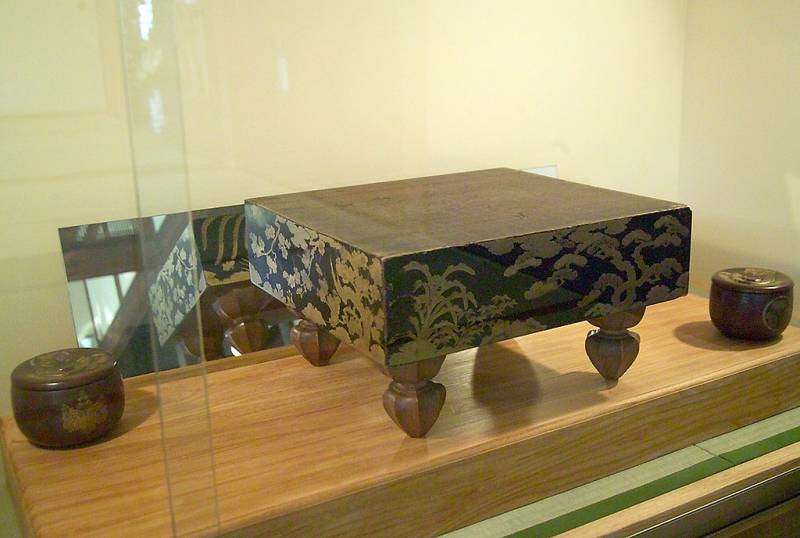
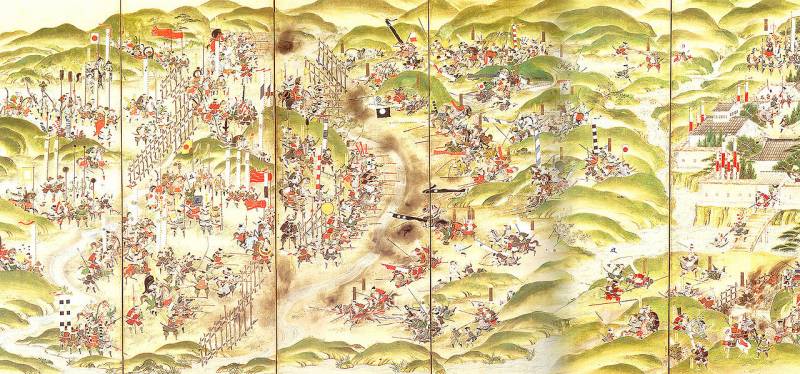
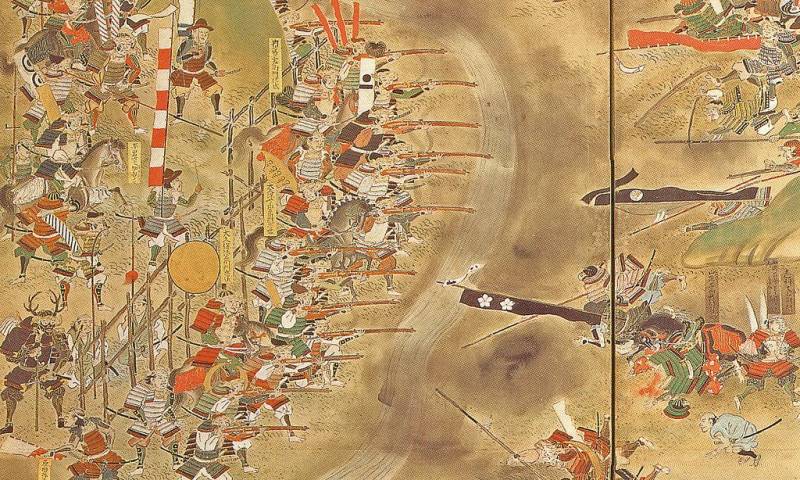
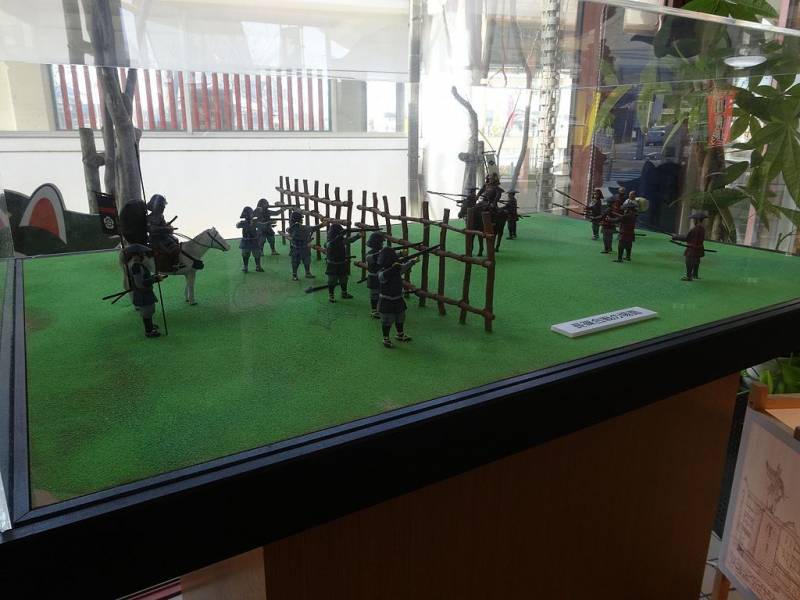
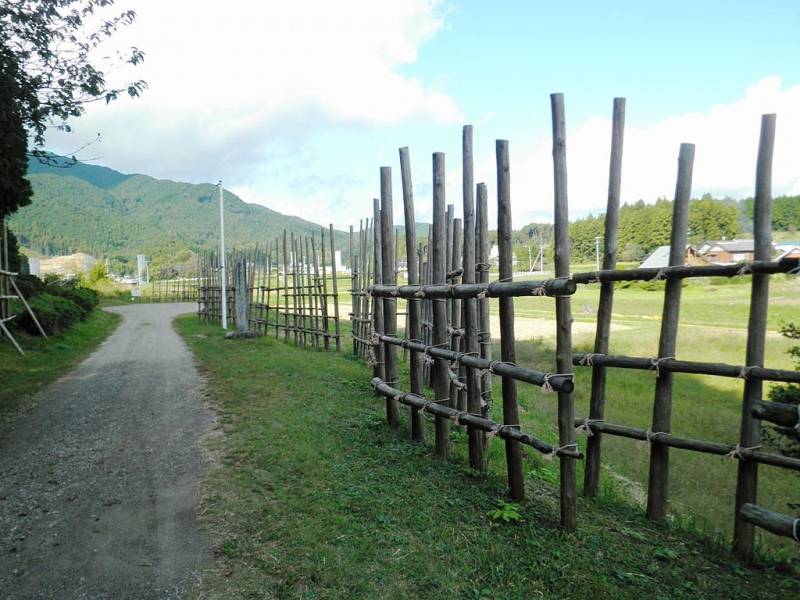
Information